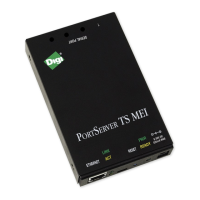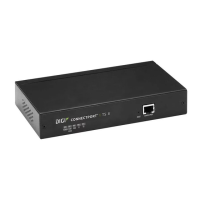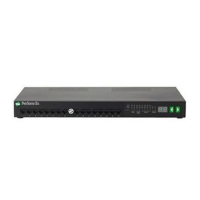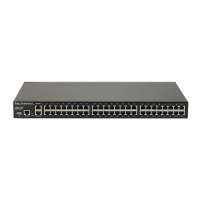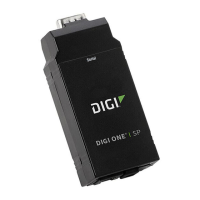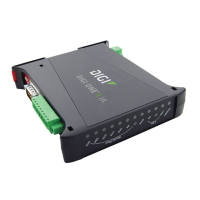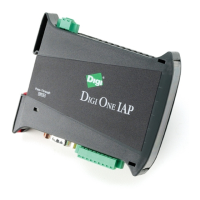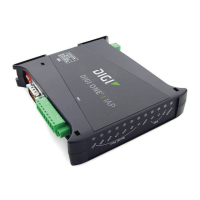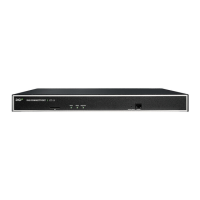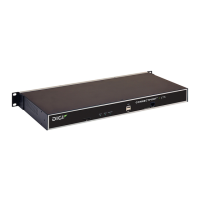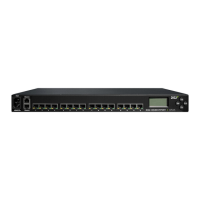Do you have a question about the Digi PortServer TS 8 and is the answer not in the manual?
| Product Type | Terminal Server |
|---|---|
| Connectivity | Ethernet |
| Flash Memory | 16 MB |
| Model | PortServer TS 8 |
| Ports | 8 |
| Interface | Serial |
| Ethernet | 10/100 Mbps |
| Network / Transport Protocol | TCP/IP, UDP |
| Remote Management Protocol | SNMP, Telnet, HTTP |
| Features | Modem emulation, Port buffering |
| Compliant Standards | FCC, CE |
| Operating Temperature | 0 °C to 50 °C |
| Weight | 1.5 lbs |
Provides an overview of the device setup process, covering planning and hardware connection.
Details the purpose, audience, and scope of the manual, explaining what it covers.
Explains how to enter commands on the device's command line interface, including line breaks.
Lists the Digi devices covered by this manual, specifically PortServer TS 8 and TS 16.
Lists additional documents available in the product library for further reference and support.
Describes various methods for configuring the device, including attached terminal, Telnet, web interface, and file download.
Outlines the necessary prerequisites and procedures for accessing the device's command line and web interface.
Details the available methods for configuring the IP address and subnet mask for the device.
Guides through configuring the initial IP address using the DPA-Remote utility, assuming no DHCP server.
Explains how to configure an IP address by manually updating a server's ARP table and pinging the device.
Provides step-by-step instructions for configuring the Ethernet interface's IP, subnet mask, and gateway via the command line.
Describes how to obtain an IP address automatically using DHCP or RARP server services.
Introduces the RealPort feature, explaining its advantages for network-based host systems.
Details the steps for configuring ports for RealPort connections using the device's web interface.
Guides users on configuring RealPort ports using command-line interface commands.
Provides a practical example of configuring all ports for RealPort using command-line commands.
Discusses important considerations for configuring ports for printers, including flow control and protocols.
Explains how to configure ports for printer connections through the web interface.
Provides instructions for configuring printer connections using the command-line interface.
Describes two methods for configuring ports to allow direct printing access via Telnet.
Explains how to configure ports for terminal connections using the web interface.
Provides instructions for configuring terminal connections using the command-line interface.
Discusses configuring computer connections, highlighting differences from terminal connections.
Offers tips for configuring modems to work effectively with the PortServer TS 8/16.
Details how to configure ports for modem connections using the web interface.
Guides on configuring ports for incoming-only modem connections via the command line.
Explains how to configure ports for outgoing or bidirectional modem connections using the command line.
Details how to configure PPP connections using the device's web interface.
Provides instructions for configuring inbound PPP connections via the command line.
Guides on configuring outbound PPP connections using the command-line interface.
Provides introductory information on the concept and purpose of IP routing.
Explains RIP routing updates, their benefits, and potential issues like slow convergence.
Details how to configure static routes for the PortServer TS 8/16, specifying destinations and gateways.
Guides on configuring dynamic routing using RIP, including handling updates and convergence issues.
Explains how to configure Proxy ARP to facilitate packet routing between networks with the same IP address.
Introduces the autoconnection feature, allowing automatic connection to a host.
Describes how to configure a port for autoconnection using the web interface.
Guides on configuring a port for autoconnection using command-line interface commands.
Explains how to configure a user for autoconnection via the web interface.
Guides on configuring a user for autoconnection using command-line interface commands.
Introduces console management, allowing remote access to serial ports of network devices.
Details how to configure console management features using the device's web interface.
Guides on configuring console management using command-line interface commands.
Describes how to control access to the device's configuration, differentiating root and regular users.
Explains methods for controlling access to inbound serial ports, including default restrictions.
Details methods for controlling access to outbound serial ports, noting default unlimited access.
Describes how to restrict access to the device's command line interface.
Explains RADIUS and how to configure the device to use it for user authentication.
Guides on how to issue and assign passwords to users on the device.
Explains how to configure users for SSH version 2 encryption for secure communication.
Discusses key concepts of the domain name system, including purpose and components.
Details procedures for configuring DNS, including using a name server and a host file.
Introduces SNMP and network management, describing the PortServer TS 8/16 agent.
Guides on configuring the SNMP agent using the device's web interface.
Details how to configure the SNMP agent using command-line interface commands.
Guides on upgrading the device's firmware using the web interface.
Details how to upgrade the device's firmware using command-line interface commands.
Discusses remote configuration by editing and downloading configuration files from a host.
Explains how to reset the device's configuration to factory defaults or NVRAM settings.
Discusses configuring users and typical attributes like password and autoconnection.
Lists common user features and their corresponding `set user` command fields.
Explains how to configure users through the device's web interface.
Provides examples of configuring various user attributes using command-line commands.
Configures the device as a terminal server providing Telnet and Rlogin access to hosts.
Shows the device functioning as a terminal server implementing autoconnection.
Provides ports for a LAN-based host using RealPort, with simple port attribute configuration.
Uses a RADIUS server to provide a dial-in PPP connection with specified attributes.
Provides steps to troubleshoot issues where the PortServer TS 8/16 fails to complete the boot cycle.
Guides on troubleshooting problems related to accessing the device via Telnet.
Offers solutions for issues encountered when trying to access a specific port on the device.
Explains how to run hardware diagnostic procedures to validate the PortServer TS 8/16.
Details how to run the Power-On Self-Test (POST) to validate the device's hardware.
Provides a procedure to verify TFTP is working correctly on a UNIX host for file transfers.
Offers steps to check and resolve common TFTP problems encountered during firmware updates.
Explains how to reset the device's configuration to its default factory settings.
Guides on how to check and verify the IP address assigned to the PortServer TS 8/16.
Provides a procedure to ensure no other device shares the same IP address as the PortServer TS 8/16.
Explains how to use the ping command to determine if a system can be reached across the network.
Offers steps to troubleshoot network cabling issues for proper connectivity.
Guides on verifying that the RealPort daemon or process is running on various operating systems.
Details how to check and change port configurations from the command line interface.
Provides contact information for Digi International's customer service and support.

